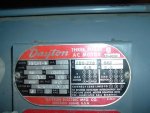Open Neutral
Senior Member
- Location
- Inside the Beltway
- Occupation
- Engineer
Got a phone query re: installing a replacement Dayton 2NKX7 3ph 208-230/480V 1.5 HP motor.
They are running it on 208, and when wired for "low voltage" it hums, period. They restrapped it for "high voltage" and it runs. I can't see a diagram at the URL so am taking their word for it. The dead motor it replaced was strapped exactly as this one's "high voltage"....
The obvious answer is the sheet with strappings is wrong, but I find that dubious. I told them to measure each leg's current and compare to the spec. Other than that, it will take some eyes-on.... and it's 36 ft in the air on an exhaust fan.
Suggestions?
They are running it on 208, and when wired for "low voltage" it hums, period. They restrapped it for "high voltage" and it runs. I can't see a diagram at the URL so am taking their word for it. The dead motor it replaced was strapped exactly as this one's "high voltage"....
The obvious answer is the sheet with strappings is wrong, but I find that dubious. I told them to measure each leg's current and compare to the spec. Other than that, it will take some eyes-on.... and it's 36 ft in the air on an exhaust fan.
Suggestions?


